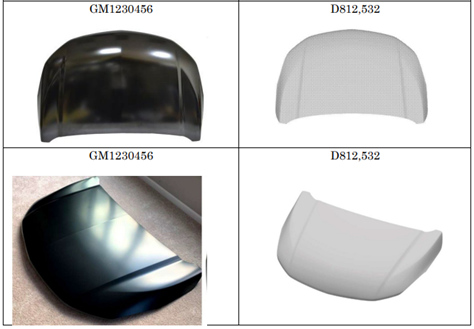LKQ Corporation filed suit in the Northern District of Illinois against defendant General Motors Company, seeking declaratory judgment that several design patents for ornamental aspects of vehicle parts were invalid as anticipated or obvious over the prior art and covered unpatentable subject matter. The plaintiffs filed a motion for summary judgment on the grounds that the asserted patents were invalid as not design-patent-eligible under 35 U.S.C. § 171. This motion was denied.



LKQ moved for summary judgment on the grounds that the asserted patents were invalid for, among other things, failing to claim a complete design of “Articles of Manufacture” under 35 U.S.C. § 171. More specifically, LKQ argued that the asserted design patents claimed ineligible subject matter for two reasons: that the patents do not claim a complete “design” or, alternatively, they do not disclose a complete “article of manufacture.” According to LKQ, the asserted patents do not reflect “designs” within the meaning of § 171 since they claim portions of a larger design: the entire exterior of a vehicle. Both arguments failed.
The district court found that “LKQ’s first argument — that the Asserted Patents fail to claim a complete design — is not supported by the language of § 171 and is contrary to binding authority. Section 171 does not speak to the scope of a claimed design, and the text of the statute contains no requirement that a design cannot relate to a component part of a product.” LKQ Corp. et al v. General Motors Co. et al, Order on Pls.’ Mot. Summ. J., 1-20-cv-02753, at 27, (NDIL) ECF No. 332. To be sure, the district court pointed to several binding decisions, including the US Supreme Court’s decision in Samsung Elecs. Co. v. Apple Inc., as confirmation that “a design for an article of manufacture may be embodied in less than all of an article of manufacture.” Id.; Samsung Elecs. Co. v. Apple Inc., 580 US 53, 61 (2016) (“The Patent Office and the courts have understood § 171 to permit a design patent for a design extending to only a component of a multicomponent product.”).
LKQ’s second argument — that the term “article of manufacture” in § 171 does not apply to components of a single article of manufacture — fared no better and “ran straight into a brick wall.” LKQ Corp., 20-cv-02753, at 28, ECF No. 332. According to the district court, Samsung made it clear that the “article of manufacture” “encompasses both a product sold to a consumer and a component of that product.” Samsung, 580 US at 60. While Samsung implicated the term “article of manufacturer” for damages under 35 U.S.C. § 289, not validity under § 171, the district court nonetheless found that “the Federal Circuit has applied Samsung in the invalidity context and concluded that design patents claiming the ornamental aspects of component parts constitute complete designs for ‘articles of manufacture.’” LKQ Corp., 1-20-cv-02753, at 29, ECF No. 332. Simply put, design patents claiming a component of a larger product are not inherently invalid.
The plaintiffs further motioned for an interlocutory appeal questioning whether 35 U.S.C. § 171(a) permits the issuance of a design patent that covers just part of a larger design. This motion was also denied for similar reasons. In the denial, Judge Jeremy Daniel emphasized the importance of the design patent claims. The asserted patents claimed vehicle parts, not entire vehicles. Therefore, the vehicle parts are components of a vehicle and are “articles of manufacturer in their own right.” LKQ Corp.et al v. General Motors Co. et al, Order on Pls.’ Mot. Interlocutory App., 1-20-cv-02753, at 2, (NDIL), ECF No. 357.
Practical Considerations
It may be beneficial for practitioners to parse novel ornamental features of an article into numerous design patent applications. This technique enhances intellectual property protection by having the option to enforce the multiple design patents, either in combination or individually.
Practitioners should also consider the viability of claiming the entire product. Under 35 U.S.C. § 289, patent owners are entitled to an infringer’s total profits. Profits from an entire product are typically more than the individual parts for the product. Thus, resulting in a larger damage award.






 />i
/>i

